(cont.)
ON: Which plant
can you mention as a good example of perfume? The scent is due to
presence of which plant?
SB:
Many species are fragrant. I believe in the theory that ascribes
it to a consequence of an evolution process, the necessity of being
adapted to environment, a way of attracting pollinator. Monofoliate
Cattleya species are my favorite, many bifoliate have strong scent.
Some have interesting particularities, lemon scent, cinnamon, chocolate,
eggs, etc. An example of perfume connected to the color, Potinara
Helga Margaret Gray in pumpkin color, curiously scents a pumpkin.
When the flowers are red, the scent is not so strong. Although most
hybrids do not present this quality in a remarkable way, this characteristic
increases the value of the orchid, deserving a special attention
during the show with a particular judgment of perfume. Concerning
the commercial point of view, the scent is a motivation for the
sale. I have already heard customers say that they only buy plants
with scented flowers.
|
Potinara Helga Margaret Gray
(Pot. Red Crab
x Blc. Pokai Tangerine) |
ON:
You said that the plant vigor is very important for the orchidist,
what advice could you give about it?
SB:
In the meristem, the plant has been selected because it is vigorous,
floriferous, beautiful and resistant flowers, etc. Nobody will clone
something if it is not good. You should not only see the blooming,
the top of the plant can be yellow, almost dead but consumer charmed
by the flowers can not see that. You should also look the bottom,
see the general conditions, the plant vigor. The orchid has an intrinsic
high value, you should buy from someone very serious, a good cultivated
plant, it is always desirable.
ON:
Brief...
SB: It takes long time to select good matrices and without them,
it is not useful to have good intentions, to have the knowledge.
The good plants should be present so the breeder could guarantee
the cross. The market never received so great quantity and diversity
of good quality plants like now making easier to obtain good matrices.
So, you have just to work...
ON:
Cattleya Enid (C. warscewiczii x C. mossiae),
registered in 1898 (Veitch), is until know found in the market and
is a hybrid that has been redone many times, as a matter of fact
it is present in the genealogy of more than 6.000 registered hybrids.
Bc Pastoral (l961, Rolf Altenburg), Lc Persepolis
(l973), Lc Amber Glow (1952), Cattleya Portia
(1897) are still found for sale and in the collections. Which is
the secret?
SB:
Those mentioned plants and many others became a landmark in the
evolution of the hybrids, they will be always desirable ... The
precept is: “Beauty is never out of fashion”. Cattleya
Enid is an excellent matrix. Blc. Alma Kee meristem is
famous, although not very fecund, it is dated from 1975 and it is
still a commercial success.
ON:
Another hybrids even more recent disappeared, others are difficult
to be found for sale such as Cattleya Sonia Altenburg (Rolf
Altenburg, l963) which is just found in collections. The clone ‘Donna’
of this plant has already received an AM/AOS with 81 points, in
2.000. Speaking in a general way, which would be the reason of the
long last or the disappearance of the high qualities plants?
SB:
Pomp and Circumstance ... When you have judgments with official
recognized awards, the plants become famous, worldly recognized,
which make those plants better known and objects of desire, stimulating
the production and the consumption. This is linked to quantity of
media the plants are exposed.
It is a matter of moment, may be the plant has received the award
in the right moment, the plant can be commercially good because
it is long last, because it has a particular color or it blooms
in a specific date, etc. Bc. Pastoral is may be the most
known Rolf's plant; it was done in high scale, the flowers open
in a good period, they come to Mothers' Day. C. Sonia Altenburg,
a wonderful semialba, even today would provoke a good "fight".
I have seen many good plants from this excellent hybrid; someone
in Jundiaí, Rodrigues, cultivated at about 20.000 plants
he used for cutting; not meristem, they were seeded... You could
find plants which were excellent. It is a plant that, although very
beautiful, it has a commercial drawback; the peak of blooming is
January and February... The market for decoration is retracted in
São Paulo. Blc. Toshie Aoki and Lc. Amber
Glow are excellent matrices but their direct hybrids blooming in
the same period of the year. So we have a Blc. Chia Lin,
a Blc. Chunyeah which are much more famous because besides
having the fashion color of the moment, their blooming happens very
close the great orchid events and important date, reasons enough
for reproducing them in greater quantity. You have very good albas
before Mothers' Day, but those which became famous are those which
open for Mothers's Day, those which bloom for brides's month (May).
ON:
You mentioned Blc. (Rsc.) Chia Lin and Blc. (Rsc.)
Chunyeah, both having a strong presence of C. dowiana,
almost 50 and 60%, respectively. Ernest Hetherington said that some
hybrids have changed the panorama, the standards of his period and
mentioned, concerning the alba, Cattleya Empress Bells,
in the decade of 40. Which were the modern hybrids that would changed
the panorama?
SB:
Cattleya Empress Bells until today has participated in
more than 1000 hybrids but if we look carefully the source of everything,
if we do an evaluation of the alba, everything is resumed in the
participation of three species: C. mossiae, C. gaskelliana,
C. trianaei, always the same species, the origins of the alba
is succession of retro-crosses always involving the three species.
The alba and lilac plant, for that reason, are plants that reached
the best shape. Rolf, for example, got a plant with a good lineage,
Bc. Turandot, C. Bob Betts X Bc. Pastoral,
and in the United States, the same happened to Bc. Orglade’s
Pink Paws result of Bc. Pastoral x Tiffin Bells. So those
hybrids impressed their mark, producing large lilac with good substance.
I have four or five hybrids done from the same origin, C.
Irmã Dulce, Blc. Lourdes Panucci, Blc.
Nobile’s Suprema, Blc. Nobile’s Magestic, etc.
Nowadays we can say that the improvement comes from the Est; It
is hard not to admire nor use in crossings plants like Blc.
Chia Lin, registered 20 years ago (1989), Blc. Chunyeah,
1991, Lc. Chyong Guu Swan, 1995.
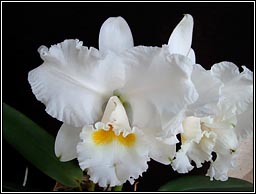 |
C.
Nobile's Virgin 'Augusta'
Comment:
Result of a cross from C. Virginia Ruiz and de C.
Floralou, this hybrid has in its genealogical tree traditional
plants like C. Francis T C Au, C. Tiffin
Bells, C. Bow Bells, it means a strong presence of
C. gaskelliana, mossiae, trianaei as well as C.
warneri.
They are vigorous plant, good substance and bear up to
4 flowers per spike, at the end of the Springtime. |
ON:
Which hybrids can you still mention?
SB: Cattleya Horace, 1938, gave origin to more than 200
hybrids, some good yellow and red we have today. It is a lilac which
was in "silent" and, suddenly, in the Est, has been crossed
with yellow; and just started to produce good yellow and red flowers.
When you crossed Lc. Edgard Van Belle x C. Nigrella
you have Lc. Belle of Cell which has already peach color.
When you crossed Lc. Belle of Celle with Norman’s
Bay, you have Blc. Oconee where you have C. Fabia
(dowiana x labiata) many times. Blc. Oconee crossed
with Blc. Maitland produces Blc .Chia Lin which
is really big. It calls attention for having a very good behave
in terms of rhizome.
ON:
You mentioned Blc. Norman’s Bay which is in Blc.
Chia Lin's tree and is also an very old hybrid.
SB:
Blc. Norman’s Bay has been a success but, today,
commercially it out of question. It is beautiful, large, productive,
with 4 flowers by spike but the rhizome is too long, it doesn't
stay inside the pot. Nowadays, if you want to talk about a plant
that people call red which is in fact magenta, you should start
with this “Top of line” of the category: Blc.
Chia Lin. It is almost constrained to work with a Blc.
Chunyeah, one of the the best matrices to produce yellow.
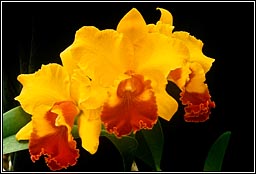 |
Blc.
Nobile s Golden Top (Blc. Dal’s Horizon x Blc.
Chunyeah)
Comment:
A cross of Blc. Chunyeah and Blc. Dal’s
Horizon. The presence of Blc. Dal’s Horizon
(which can present a salmon color) gives to some plants of
this hybrid a yellow color more vivid than that showed by
the parents. |
ON:
Coming back to C. Horace, which plants in its progeny stand
out as matrices with quality?
SB: Blc. Goldenzelle (x Blc. Fortune), Lc.
Drumbeat (x Lc. Bonanza), Lc. Prism Palette. (x
Lc. Colorama), Lc. Melody Fair (x Lc.
Stephen Oliver Furaker), Lc. Til (x Lc. Van Dick)
and after another generation from Blc.Goldenzelle: Blc.
Nobile’s Golden Horizon, Blc. Suzuki Belle, Blc.
Candelario Garcia, Blc. Legend of Maui, Blc. Dal’s
Horizon.
ON: Nowadays, the best matrices have an origin different
from those used in the past?
SB:
In fact, the novelties always arise from a recombination of anterior
lineage, it is a continuous process. Who does a hybrid, most time,
is benefited by a hybrid done before, or, at least, from the information
got from the anterior breeding. In Brazil, Rolf Altenburg did a
good part of his hybrids from a French lineage, from Vacherot &
Lecoufle's matrices. Vacherot has done many hybrids in Cattleya
in a certain time. Everything done in French in terms of improvement,
he brought to Brazil. From the United States, Hawaii, George Suzuki
introduced many plants. The American, Japanese and then the Chinese
people used another lineage, another combinations not used before,
dominating un another moment the orchidist world.
In the last two decades, we have a huge jump in terms of quality
concerning the Cattleya hybrids. Just to talk about the
medium plants, our bifoliate originated many wonderful, spotted
and flamea hybrids done in Hawaii. Now, we are taking advantage
of some wonderful plants created by the Chinese people. Even with
the globalization, due to the genetic characteristics of the orchids
and due to the reproduction processes, this evolutive movement is
counted in decades.
ON:
Let's talk a little about you. When did you found Nobile's Orchids?
SB:
In 1994, I started with Dendrobium nobile thus the name
of the company. More or less 2 years later, I intensified
Cattleya hybrids with the mark Nobile.
ON:
Always we talk about breeding in Brazil, your name is mentioned,
we can not deny your participation in the scenery. You have really
champion plants such Blc. Nobile’s Bruno Bruno with
cooper colors.
SB:
When Blc. Nobile’s Bruno Bruno appeared, in Brazil,
there was nothing similar. In the United States, there was something
similar but coming from another lineage. I have remade Bruno Bruno
5 or 6 times, in the total from 15 to 20.000 plants... I haven't
seeded it however, as I have many varieties, I am doing meristems.
Nowadays, we have a good progeny of the first and the second generations
which are excellent matrices.
ON:
When have you done Blc Bruno Bruno? It is your main creation,
isn't it?
SB: It is from 99 and is, no doubt about, one of the most known.
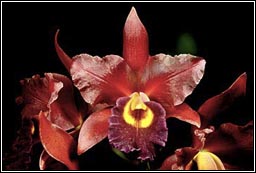
Blc. Nobile's Bruno Bruno 'Purple Princess' |
Blc. Nobile's Bruno Bruno 'Purple Princess'
A
cross of C. Chocolate Drop × Blc.
George Suzuki blooming from the Springtime to Fall.
They are vigorous plants which bear from 6 to 9 flowers,
with an extraordinary substance and brilliant texture.
Dark red is the dominant color but the lip can be magenta.
|
ON: You told it has a descent with good
results. What could you show us about this progeny?
Blc. Nobile's Scorpion (x Laelia tenebrosa), Blc.
Nobile's Tango 'Buenos Aires' (x Lc. Irene Finney), Blc.
Adventure 'Mercury (Blc. Julio Barbero), Blc.
Nobile's Petit Bouquet (Blc. Helio Mauricio Bittencourt),
Blc. Nobile`s Frisson (x Blc. Oconee ); Pot. Nobile's
Little Dragon 'Barão Vermelho' (x S. coccinea),
Blc. Nobile’s Fusion (x Blc. Chia Lin),
Blc. Nobile's Samba (x Blc. Samba Lemon Drop).
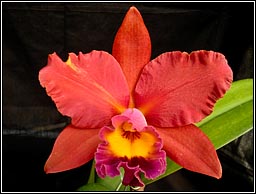 |
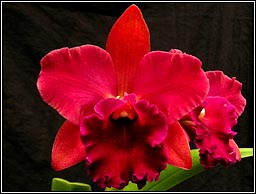 |
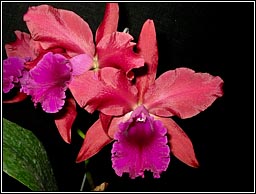 |
Blc. Adventure 'Mercury (Blc. Julio Barbero) |
Blc. Nobile's Frisson _04 |
Blc. Nobile's Scorpion |
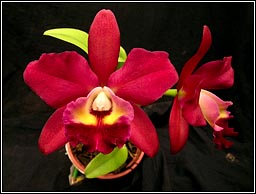 |
 |
 |
Blc. Nobile's Petit Bouquet |
Blc. Petit Bouquet 'Nectarina' |
Pot. Nobile's Little Dragon 'Barão Vermelho' |
N:
You have also plants with quite delicate color and perfume such
Cattleya Fatima Barani, a hybrid dated to 1992.
SB:
C. Fátima Barani should be produced again because
it is a plant that, commercially, is lacking. It has been done in
order to bloom for Mother's Day. The parents are Cattleya percivaliana
and Cattleya Francis T. C. Au. It is a plant that bifurcates
a lot and bears many flowers. Those are its main qualities. However,
suddenly, since the last decade until recently, lilac fell in "disgrace“
(as I have already said), in term of price in the market, we don't
know exactly why. There are some explanations, the soft lilac, soft
pink, brief orchids in There are some explanations the soft lilac,
soft pink, brief orchids with soft color, in a certain time, have
great value in the market and were done in great quantity and many
really beautiful things appeared. Many descendents of Cattleya
labiata were available and there was a great quantity of summer
and fall matrices, period where the Cattleyas most bloom in Brazil.
Many plant have been done, many things have been seeded, with out
taking in consideration the dominance of the lilac. In this way,
many generations of hybrids have been produced and progenies assumed
to produce albas, semi-alba, red and even yellow flowers, produce,
as a matter of fact, lilac, provoking a great quantity of plants
with this color in detriment of the other colors.
ON:
What are you looking for when you are making a cross? Improvement?
more floriferous plant in terms quantity of flowers or more floriferous
concerning the number of the time it can bloom a year ? The precocity
and, as a result, the profitabilitly in a shorter time?
SB: When I decided
to go to deal professionally with orchids, I chose Cattleya
hydrids and idea was to produce orchids for decoration market. The
most difficult part when we decided to work with orchid is not to
be an orchidist anymore, not to think only about the flower. In
the Japanese colony which surrounds me, some comes from the vegetable
or fruits cultivation, they are really good to make money with the
cultivation because don't have orchidist blood. If there is a group
of two thousands p.ants of a crossing, they are all to be sold ;
no one is expecting for “a” plant which will be awarded.
Some don't want to know ever the name of the crossing. In this way,
all qualities of the assemblage are important because they represent
profit which is the final aim of the production in this case.
ON: This lack of the name is complicated, making difficult
the identification. And about the nomenclature, what do you think
about?
SB: If we will
talk about nomenclature... Let's talk first about the official.
I have to adopt because I should register the plants and I am compelled
to do the registers at RHS. I was changing all my private registers
of hybrids to the new nomenclature (in my opinion it is a matter
of biologists, botanists and psychiatrists...), but I gave up because
for my work it is not useful. When we said, for example, this a
a Sophrocattleya, Sophrolaelia, Potinara,
I knew what I could approximately, expect, I could say something
because I knew that Sophronitis has some kind of dormancy
in terms of size, number of flowers, colors. I already have an idea
about the characteristics I could expect, nowadays with the new
nomenclature, a Sophronitis can be a tenebrosa... I don't
know any more what I can expect...
Concerning the identification of the plants, labeling correctly
a plant is essential, we don't know where our production will be
sold and which is the target. Even though if the objective is only
to the decoration, why not to inform the consumer about the qualities
and the origin of the product?
ON: How
many hybrids have you registered?
SB: Until now, at about 250 registered hybrids on Cattleya,
some of them represent improvements.
ON: Which plants do you consider as the best, besides Blc.
Nobile's Bruno Bruno, of course.
SB:
I consider some crossings that offered plants com expresive
qualities:
Alba: C. Irmã Dulce, C. Senadora
Heloisa Helena, and more recently C. Nobile’s Fá;
Lilac: Blc. Nobile’s Harmony, Blc.
Nobile’s Magestic, Blc. Nobile’s Bets, Blc.
Nobile’s Suprema;
Semi-alba: Blc. Nobile’s Belle, Blc.
Nobile’s Glimmer;
Dark:Blc. Nobile’s Blush, Pot.
Nobile’s Diva, Blc. Nobile’s
Tango,
Coerulea: Lc. Nobile’s Blue Star
e Lc. Nobile’s Blue Sky
 |
Lc.
Nobile's Blue Star (Lc. Mini Purple x C.
Claesiana)
Comment:
Descendant of Cattleya Claesiana flamea coerulea
and Laelia pumila coerulea, was done for producing
flComment:
Descendant of Cattleya Claesiana flamea coerulea
and Laelia pumila coerulea, was done for producing
flamea and coerulea flowers precociously (characteristicsC.
intermedia and L. pumila) which actually produces.
However in this cross, C. intermedia is the flamea
and it is in the composition of C. Claesiana, on
the other hand Lc Mini Purple is not flamea, it means,
only a quarter of the plants of Lc. Nobile’s
Blue Star is flamea.
Now those plants are appearing the the shows with their whole
potential which from five to six flamea and coerulea flowers
really making a wonderful assemblage to be admired. |
Orange:
Blc. Nobile’s Thatha, Blc. Nobile’s
Tropicana, Blc.
Nobile’s Bronze 'Golias'
|
|
Blc.
Nobile’s Tropicana |
Blc.
Nobile’s Bronze 'Golias' |
Yellow: Blc. Nobile’s Golden Light,
Blc. Nobile’s Golden Top, Blc.
Nobile’s Golden Dunes,
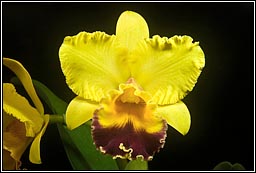 |
Blc.
Nobile’s Golden Dunes |
Flamea:
Blc. Julio Barbero, Lc. Nobile’s Affair, Blc.
Nobile’s Tropical Sunset, Blc. Nobile’s Wildfire,
Blc. Nobile’s Summer Dream;
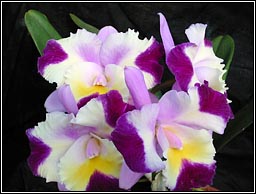 |
Lc.
Nobile’s Affair
Comment:
It is a cross of C. Lulu × Lc.
Beatriz Künning which flowers in Spring.
They are vigorous plants which produce from 3 to 5 big flowers.
Its color varies from vivid lilac with flame varying from
dark lilac to yellow. |
Multiflora: Blc.
Nobile’s Honey, Blc. Nobile’s Pop, Blc.
Nobile’s Salute e a Blc.
Nobile’s Soleil.
Blc. Nobile’s Soleil
It is a cross
of Blc. Kure Beach × Lc. Blazing Treat
which flowers in Spring.
Precocious plant which bears many flowers from 4 to 6cm across
and presents color varying from the yellow to orange.
|
 |
ANOTHER HYBRIDS
 |
Blc. Nobile's Tropicana
Comment:
It is a cross of Blc. Ademar Manarini and Blc.
Eve Marie Barnett which blooms in Summer, by Christmas.
The pollinization is done in December between excellent matrices,
long last and good shape flowers, one is yellow and the other
is red or pumpkin color.
Blc. Nobile's Tropicana is excellent, sometimes pumpkin
color, sometimes yellows, with big and good substance flowers. |
Blc.
Nobile's Spark
Comment:
It is a cross of Blc. Haw Yuan Moon × Blc.
George Suzuki and blooms from summer to fall.
It produces from 5 to 6 medium flowers with good substance,
varying from yellow to red including pumpkin color, with brilliant
texture. |
 |
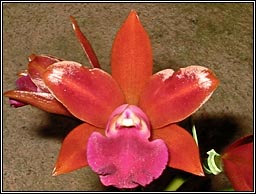 |
Blc.
Nobile's Twist 'Boquita' (Chocolate Drop x Constant Spring)
Comment:
It is a cross of Blc. Constant Spring × C.
Chocolate Drop.
It blooms in Fall.
The flowers have good substance and the texture is coriaceous,
characteristics of the two plants involved.
Its color varies from yellow to chocolate and the spikes bear
from 5 to 7 flowers. |
Blc.
Nobile’s Baby
Comment:
It is a cross of Lc. Chocotome Gold e Blc.
Ademar Manarini. flowers in Summer.
The spikes are multiflora and its flowers have a brilliant
texture, measuring from 5 to 7 cm, the vivid color varies
from yellow to red.. |
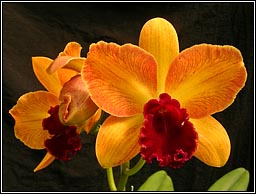 |
|
|
|
Blc. Nobile's Festiva |
Blc. Nobile's Fortune |
Blc. Nobile's Golden Show 'Plana' Hawaiian Galaxy x Toshie Oaki |
|
|
|
Blc. Nobile's Starlux |
Blc. Nobile's Goldfish '#7' |
Lc. Nobile's Puppet |
ON:
Thanks, Sérgio Barani
Photos: Sérgio Barani and Marco Antonio Campacci
|